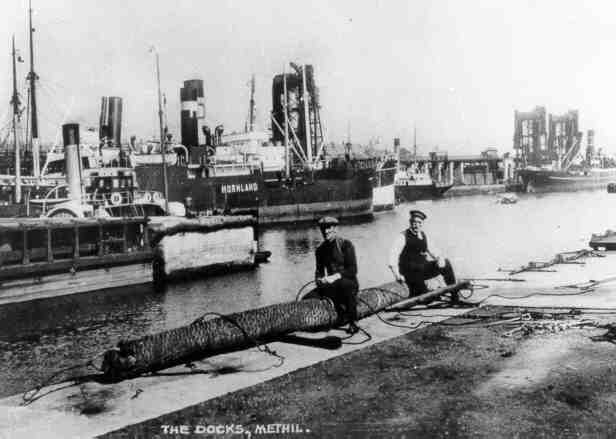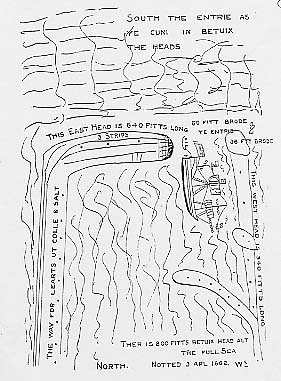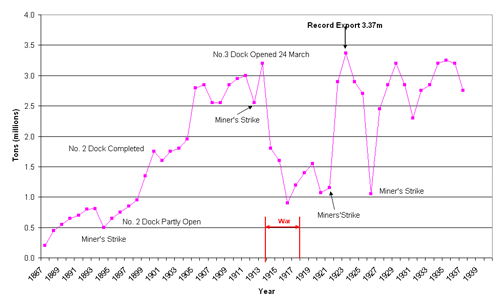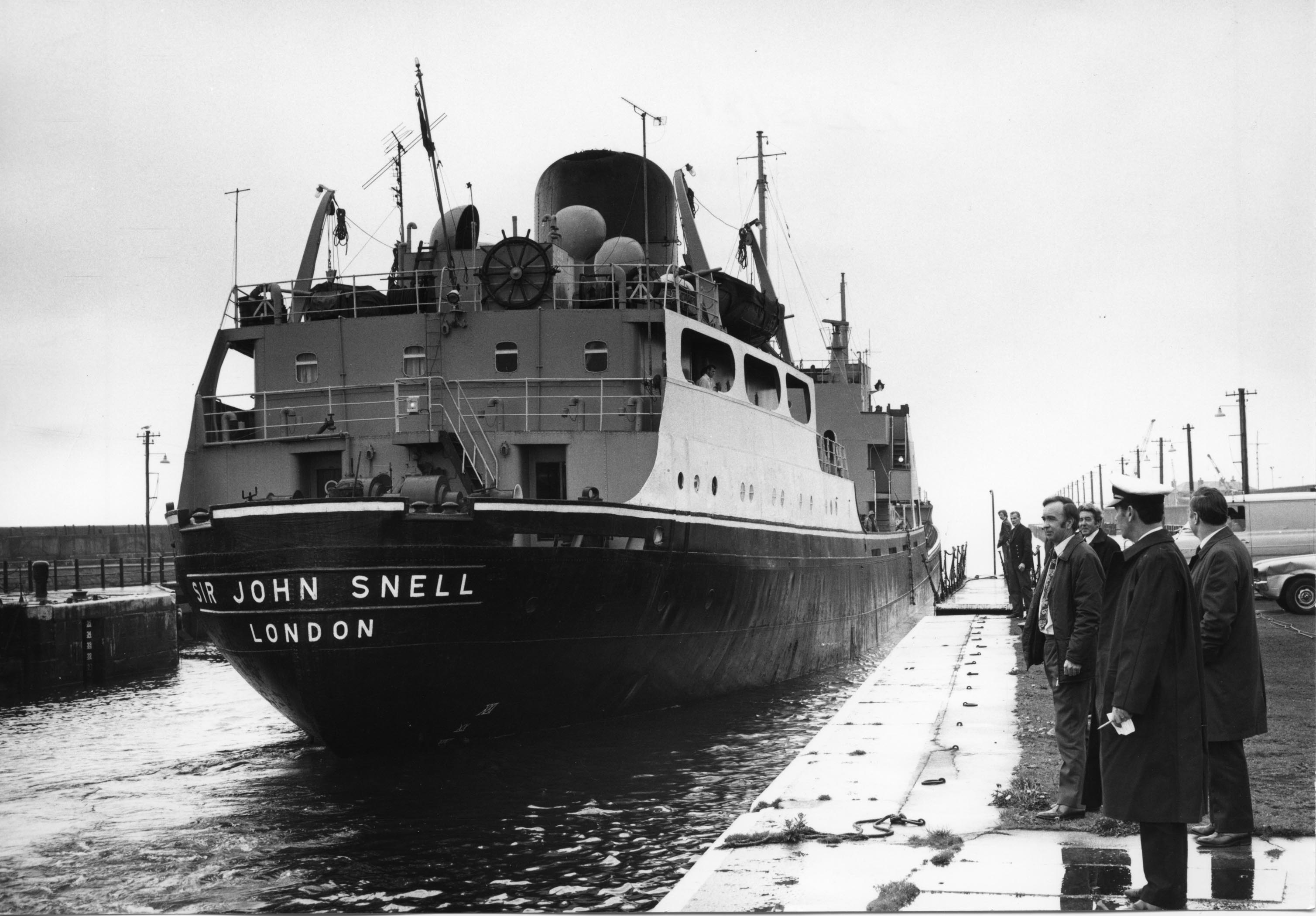METHIL DOCKS
Methil Herbure, 1664 |
|
"On 15th September 1664 Andrew Thomsone in Leiven did lead his Botte in the new Harboure of Methil wt colles from the colle of Methil being 60 leads of colles and he did tak them to Leith one 17th September 1664. Which was the first Botte yet did leade wt colles att yt Harboure. The colles were well loved att Leith & since thorrow all sea ports in Scotland. I sould them att 5li the 12 lodes & 2sh to the grive. I give 22d for mining themto the coller and 1sh 2d to the caller of them from the colle pit to the Harboure." [David, Second Earl of Wemyss - From "Fringe of Gold - The Fife Anthology" - Edited by Duncan Glen and Tom Hubbard |
Methil was once the greatest coal exporting port in Scotland shipping over 3 million tons annually from three docks. It would be fair to say that coal and its associated traffic has played a significant part in the life and prosperity of the town. That significance ended on Thursday 18th May 1977 with the final shipment of coal from the port.
Forth Ports plc now own Methil Docks with two of the three original docks still operational – Nos. 1 & 2 – both capable of taking vessels up to 3,000 DWT. The port now specialises as a wood pulp and timber distribution centre, importing some 150,000 tonnes per year. Fertiliser imports and road salt for Fife Council, plus equipment destined for local companies are also handled. However it is a pale shadow of its former bustling self when ships from all over the world would call for coal.

Methil Docks in the 1920s
The history of Methil Docks is long and eventful; the present installation is the product of many struggles against Nature and, on occasion, of long argument in courts of law and even in the House of Lords.
Before 1664 it appears there was a wooden harbour at Methil, in that year, however, a new stone harbour was constructed by Earl David, and the second Earl of Wemyss (mentioned by Defoe in his “Tour through Britain”, 1724-26): the work was completed in the face of severe damage due to gales. Coal obtained from the “Happy Mine” at Denbeath, and from Kirkland and Methilhill, was shipped at the new harbour.

Plan of Methil Harbour - 1662
In 1789, in the “Old Account”Survey", the Rev. George Gibb spoke of the wagon way from Kirkland to Methil, and said “It would not be at all surprising to see in a few years Methil rank amongst the first coal ports of Scotland.” But the working of coal at Kirkland ceased in 1790: the “Happy Mine” was no more: and in 1803 the east pier of the harbour was destroyed by a severe gale.
In 1815 General Wemyss, who was now the Laird of Wemyss, applied to the Government of the day for a loan of £5,000 (£365,200 today) or a grant towards the rebuilding of the harbour. He pointed out that the original harbour had been built by the Wemyss family more than a hundred years previously, and that the Government drew custom dues from £8,000 - £10,000 per annum (£584,000 to £730,400 today) on salt exported from the harbour. No loan or grant was forthcoming, however, and the harbour remained in its ruinous condition until 1838. In that year the sum of £1,800 was spent on repairs to the harbour by the Wemyss family, but there was little to justify such expense, for by 1830 the salt industry had collapsed and the coal trade was practically non existent. Even in 1860 only a very small amount of parrot coal (so called because of from the crackling and chattering sound it makes in burning) from Methilhill was being shipped.
A revival began in 1864 when Bowman and Co., began to develop Muiredge pit. Mr Randolph Gordon Erskine Wemyss, or more commonly “The Laird” – mindful of the item in his ancestor’s diary “…many good colles …att Methill” realised that an outlet would be required for this coal. Accordingly he purchased the Leven dock for £12,000 (£853,595 today) from the Leven Harbour Board in 1879. By 1880 the Leven pits were working and Muiredge was increasing its output: indeed between 1870 and 1880 the coal output of Fife had doubled. Soon Bowman and Co. was shipping about 40,000 tons of coal per annum at Methil harbour: and the Fife Coal Co., were shipping a like amount at Leven Dock.
Traffic at Leven Dock, however, was being increasingly hampered by accumulations of sand and it was obvious that soon Methil harbour would be totally inadequate. The Laird, writing in his diary in 1905, said, “Owing to the railway rate of 1/- (5p) per ton to Burntisland Dock, which was the only shipping port of any accommodation, except Charleston and Alloa, I determined to put down a dock at Methil, specially with a view to providing a dock for the third class coalfields which lay practically within the confines and which its small old ports were unable to cope with …”. His tenants, the Fife Coal Co. and Bowman and Co. agreed to ship a certain fixed tonnage as a minimum, and so the way was now clear for action.
In 1883 the Laird applied for powers to build a dock at Methil, which were granted. The engineers were Messrs Cunningham, Blythe and Westland and the work was pushed forward with such energy that the dock was opened on the 5th May 1887. It was an occasion of great local rejoicing: there was a procession of bands, fishermen, miners etc: there was a contingent from Buckhaven who were the first to travel on the Buckhaven to Methil rail line, opened the same day: and in all, it was estimated that a crowd of 15,000 took part in the ceremonies.
The SS Newhaven was the first vessel to enter the new dock.
At the luncheon after opening the Laird pointed out the advantages of the new enterprise. He mentioned the installation of electric light, the provision of powerful hoists, the facilities for fishermen in the outer harbour (which he was prepared to increase “…at the slightest encouragement “, the early provision of a loop line at Thornton to enable west Fife coal to come to Methil without shunting: and he ended “…should we see that a larger area of dock accommodation is required, that hour will we at once start to meet this requirement by increasing its size – aye, doubling or trebling it even, if necessary”. The Laird was a man of great vigour.
Unfortunately at this time there was a fall in the price of coal and wages fell as low as 4/- (20p) per day in 1888. The shipments at Methil, however, were sufficient to enable Methil to take its place beside Burntisland as a coal exporting town.
The North British Railway Company (NBR) now comes on the scene. Until the building of the Thornton to Methil line they had possessed the monopoly of transport in Fife. To preserve this monopoly they began to negotiate the purchase of the railway and the docks. An agreement was signed on January 11, 1889.
The purchase price was £225,000 (£17.83 million today), with the Laird to have a seat on the Board of the NBR. At the time of transfer the dock and railway were producing income at the rate of £9,000 per annum (£713,128) today), coal being shipped at 4½d (1.9p) per ton (net).
The NBR, however, were not aware that they had invited a stormy petrel into their nest. The Laird had hardly taken his seat before he began to agitate for an increase in shipping accommodation at Methil, maintaining that among the conditions of sale was one that NBR had promised to increase the size of the dock facilities as soon as it became apparent that such an increase was necessary. He remembered also his promise at the opening of the first dock. After considerable argument the NBR finally applied for and obtained Parliamentary powers for the construction of No.2 dock.
An agitation immediately arose for the extension of Burntisland docks instead of an addition at Methil – and it was not until 1894 that construction was begun at Methil. It appears, in fact, that work was only begun after the Laird had threatened to provide additional facilities himself for the export of the rapidly increasing output of the Wemyss coalfield. No.2 dock was partially opened for traffic in July 1897 and completed in January 1900. The tonnage of coal exported for 1900 was 1,681,628 tons, a million tons more than the 663,403 tons exported in 1890.
In 1903, however, Mr Wemyss again approached the NBR with a request for a further extension at Methil. The railway company declared the facilities were adequate. The Laird was not daunted. He pointed out that accommodation for a further 1,200,000 tons annually was required, and that a new dock should have greater width and depth of gate. He further pointed out that the solution was the construction of (a) an NBR dock, (b) a Wemyss dock or (c) a combined NBR and Wemyss dock. The NBR directors were not impressed, and maintained that Methil was large enough, adding “…a large proportion of West of Fife coal could be shipped at Burntisland.”
The mention of Burntisland apparently acted on the Laird as does the proverbial red rag on the bull. In 1905, he promoted a Bill to construct a dock at Buckhaven, to be called the Wemyss dock. The Bill was rejected by the House of Lords. In the original agreement with the NBR in 1889 it had been stipulated that neither Mr Wemyss nor his tenants would build docks in Fife: but there was an agreement mentioned above, that the NBR would supply adequate facilities. Their Lordships, therefore, “…did not at present see any sufficient reason for relieving him (the Laird) of the agreement he has entered into with the NBR Company, while there are still hopes of the necessary accommodation being provided from some other source.”
The ‘other source’ was apparently the NBR, for by November 1905 they had plans for a new dock at Methil. The water area was to be 15 acres and the cost £700,000 (£58.6 million today). The plan also included the doubling of the Thornton Leven railway line at a cost of £50,000 (£4.18 million today). But Mr. Wemyss, not satisfied with certain offers made concerning the facilities, decided to proceed with his dock at Buckhaven. Both schemes were considered in the House of Lords and after some negotiation agreement was reached and on 2nd August 1907 the Act authorising the construction of the new dock at Methil was given the Royal Assent.
Work was begun on the new dock by 1907 which was much larger than the two other docks, a massive engineering undertaking with its entrance channel and sea wall along the front of the existing docks. The engineers were Messrs McAlpine and Sons of Glasgow and they had stiff opposition from the elements. Derricks and cranes were swept away by a gale in March 1909: in January 1910 more damage was done, derricks again being destroyed, along with 100 yards of the parapet wall. In January 1912, when the dock was far on its way to completion, a tremendous storm burst in 300 yards of the quay wall and flooded the dock. In the storm the SS Ashgrove struck on the parapet wall and was a total loss. The engineers pushed on with repairs and the dock was opened on 22 January 1913, when Mr John Flucker of St. Crowels, Innerleven, had the honour of bringing the first vessel into the dock. However, the dock was not available for trade until the 24th March of that year. It was intended to have eight hydraulic coal hoists, but only six were ever constructed.
The dock appeared to be haunted by a hoodoo, for very soon the sill of the dock gates sank and had to be rebuilt. Thus, during the first Great War the new dock was out of action. The port was used during the war as a convoy collecting base and the coal trade suffered as the war went on. It was not until 1923 that the export of coal rose over the 3 million ton mark.
| Dock | Water Area (acres) | Quay Length (ft) | Width of Entrance (ft) | Depth of Water on sills (ft)* | Coal Hoists | Ordinary Cranes |
| No.1 | 4.75 | 1,900 | 50 | 23 | 1 | 6 |
| No.2 | 6.50 | 2,310 | 50 | 27 | 3 | 2 |
| No.3 | 16.25 | 6,000 | 80 | 32 | 6 | - |
* Depth given at spring tide - 5 feet less at neap tide
After the First World War, Methil became Scotland’s prime port for coal shipments, exporting over 3m tons annually, as shown in figure 1. In 1923 the docks were taken over by the LNER at the amalgamation of the railways, but no changes were made. The import trade from 1924 onwards varied between 50 and 60 thousand tons; the largest tonnage imported being 125,587 tons during the general strike of 1926.
Figure 1 – Coal exports from Methil Docks 1887 to 1939

On the outbreak of the Second World War coal exports all but disappeared, Methil becoming yet again a convoy collecting base under the control of the Royal Navy.
The General Election of 1945 saw the Labour Party returned to form the first post-war government. It quickly set about the task of reconstruction and overcoming the shortages arising from the war years. New radical policies were introduced, such as the creation of the Welfare State, a key component being the National Health Service, with free health care at the point of use. This was followed by the public ownership of the Bank of England, the coal industry, railways, road haulage, electricity, gas, and the steel industry. The effect was to remove Methil Docks from the control of the LNER to the newly formed Railway Executive in 1948.
With the ending of the war coal exports from Methil resumed but never again reached the level of the 1920s and 30s. In only ten post-war years, of which the last was 1963, did coal exported from Methil exceed one million tons. In that year Methil was removed from the control of the Railway Executive to a new government body – The British Transport Docks Board.
During the 1960s trade through the docks was badly hit with the closure of all the nearby collieries, including the Wellesley in 1967 and the Lochhead pit at Coaltown of Wemyss in 1970. Manning levels declined from a pre-war high of 16 squads each of 12 men, 160 trimmers and 80 shoremen to 4 squads – a total of 60 men.
The management of Methil docks changed yet again when in December 1967, the Forth Harbour Reorganisation Scheme, constituting the Forth Ports Authority (“FPA”), became law by Act of Parliament. Forth Ports was a public trust port responsible for six ports grouped within the Firth of Forth namely - Leith (a trust administered port), Granton (a private company), Grangemouth, Methil and Burntisland (all controlled by British Transport Docks Board) and Kirkcaldy (owned by the Burgh of Kirkcaldy)

The cessation of coal shipments greatly reduced the amount of business handled by local shipping agent S.H. Olson & Co., who formerly acted for the National Coal Board. The end of the coal trade and the closure of Number Three Dock resulted in 20 redundancies among the employees of the Forth Port Authority. It was a sad day with only a few dockworkers turning out to watch the last coal shippment sail from Methil. The then Senior Harbour Master at Methil, Captain Richard Taylor, commented as the SS Sir John Snell sailed - "It is the end of an era".
No.3 dock was closed by the Forth Ports Authority in 1977, coal exports being diverted to Leith, much to the chagrin of the local community. By the end of the 1970s No. 3 dock had been partially filled-in, all coal hoists removed, the railway network uplifted and a general programme of dismantling and demolition completed. In 1978 the Scottish Development Agency took over the transformation of the docks, spending £1,000,000 on reclaiming the disused dock and railway yards to form a 31 acre industrial site. The sea-wall was strengthened and a new access road constructed. In addition the lock gates were removed turning the docks into a tidal harbour.
For many years before the war there had been some agitation to increase facilities for imports. Steps were taken in the early 1960s to improve the situation through replacing old hydraulic lines and steam engines with electric sub-stations – new cranes have replaced the old static hydraulic versions. In 1970, £15,000 was spent on plant to discharge and store grain at the docks; a pneumatic extractor to suck grain at 60 tons per hour from ships into two 1,000 ton silos were constructed for W & J.B. Eastwood, Poultry Farms, Glenrothes.
The Conservative government of Mrs Margaret Thatcher introduced the Ports Act which enabled any port, with the permission of the Secretary of State, to become a private limited company. This Act received the Royal Assent in July 1991 and in 1992 FPA successfully transferred into the private sector as Forth Ports plc and was listed on the London Stock Exchange on 23rd March 1992.
Notes:
Daniel Defoe, the author of "Robinson Crusoe" was born in London in 1660, the son of a tallow chandler and merchant named Joe Foe and educated at a Dissenting Academy in Newington Green. His "Tour Through the Whole Island of Great Britain" was published in three volumes between 1724 and 1726. It was a work written in a vein of patriotic optimism, to encourage the British and offer them a vision of heir own grandeur and resources. He died in April 1731, alone, in hiding from his creditors and estranged from his family.
"The Old Account" refers to the 1791-1799 Satistical Accounts of Scotland. This was driven by the Church of Scotland and masterminded by Sir John Sinclair, lay member of the General Assembly, who first articulated proposals for a detailed parish-by-parish survey of Scotland in 1790. Sinclair aimed to elucidate the "The Natural History and Political State of Scotland" through involving parish ministers working to a pre-planned set of questions - 160 in all. These questions referred to geography and topography of their parish; climate, natural resources and natural history; population and related matters; agricultural and industrial production, plus some miscellaneous items. It was not until the 3 June 1799 that Sir John laid before the General Assembly "a unique survey of the state of the whole country, locality by locality".